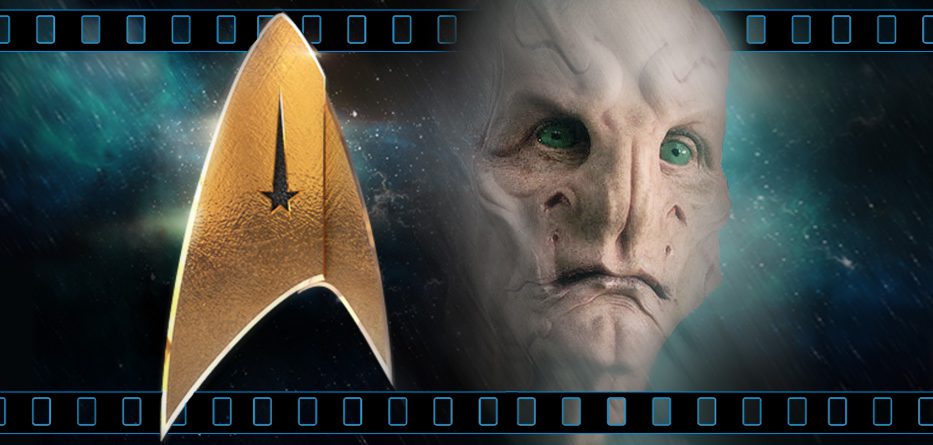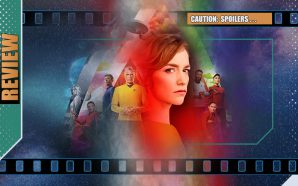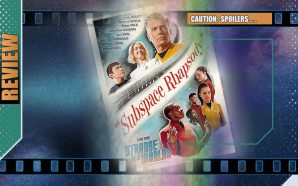On the planet Kalimar, the Kelpien society live quiet lives, working the land and coastline. Their existence is controlled by the unseen Ba’ul, a race from beyond their skies who come at regular intervals to ‘harvest’ the Kelpiens who sacrifice themselves willingly in a ritual ceremony, in the belief it will maintain their society’s circle of life. But a young member of their number, Saru (Doug Jones) dreams of what lies beyond their world and everyday lives… and he asks the difficult questions that his parents and town elders would prefer he remained silent upon.
When an opportunity comes to use his talents to retrieve and repair a piece of fallen Ba’ul technology, Saru is able to make contact not with the beings who prey upon his kind, but a race of explorers who represent an initiative known as Star Fleet…
And Saru is faced with a wonderous opportunity and fateful decision which will decide his place in the universe…
One of the most interesting things about the Short Trek concept is that succeeded in its remit to fully embrace the diversity the format promised. It would have been easy to produce something quick, easy and cheaply opportunistic. But with three minisodes down and one to go in January, each has managed to be quite different from the others, each with diverse qualities and intent, but each distilling down a shorter, sharper and more streamlined entry in the Trek mythos.
Doug Aarniokoski, with a raft of genre shows under his belt (and baseball cap) and now a much sought-after director and producer, takes time out from directing episodes of the main Discovery show (and working on the Picard show destined for later in 2019) to spotlight the ‘origin’ story of the titular ship’s First Officer Saru. Doug Jones’ alien has both been quietly enigmatic and an enigma unto himself. Jones has played him with both a fierce humility and an almost ‘English Butler’-esque rigidity, but even though the character has been something of a breakout success, we’ve known very little about his personal backstory. We know he is a Kelpien, a species with all the attributes to be timid prey rather than swooping hunters. The Brightest Star is the opportunity for us to see Saru’s first glimpse of a world beyond his own and it’s played out with a quietly noble spiritual lilt – as if an original Native American had suddenly been given the opportunity to be Neal Armstrong and take that one small step and giant leap for his own – with all the pros and cons that would entail.
Rather than pushing at boundaries, The Brightest Star unapologetically embraces one of the core elements of Trek: not the cosmic war, mirror universe intrigue but the sheer ‘boldly going’ desire to see ‘what’s out there’. No, it’s not quite James Cameron-level Avatar, but with some smart camera angles, solid prosthetics and savvy production design choices, Aarniokoski manages to use every one of the minutes and dollars available to help create a whole community and culture with only a couple of sets and some solid post-production CGI. As much as any post Next Generation adventure, this is instantly a believable glimpse of a world which we would hope to return to if the (brightest) stars align in the new run of fuller episodes.
Doug Jones continues to do for prosthetic-encased creatures of wonder what Andy Serkis is doing for motion capture: showing the performer’s talents and full potential. From the Silver Surfer in the Fantastic Four, Hellboy‘s Abe Sapien and his mere-man in the Oscar-nominated The Shape of Water, Jones has coiled and slunk his way across the screen and his Trek work upholds his score-card. There’s much to fill in between Saru’s youth to his standing on the bridge of the Discovery – especially as a return to his homeworld would bring a whole raft of practical and ethical problems for a pre-warp society, but it will be interesting to see those dots joined.
Watch out for our exclusive interview with Doug Aarniokoski about his work with Star Trek (and beyond) soon…
Star Trek: Short Treks are now available on the CBS All Access platform…












